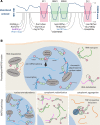Matrin 3 in neuromuscular disease: physiology and pathophysiology
- PMID: 33427209
- PMCID: PMC7821588
- DOI: 10.1172/jci.insight.143948
Matrin 3 in neuromuscular disease: physiology and pathophysiology
Abstract
RNA-binding proteins (RBPs) are essential factors required for the physiological function of neurons, muscle, and other tissue types. In keeping with this, a growing body of genetic, clinical, and pathological evidence indicates that RBP dysfunction and/or gene mutation leads to neurodegeneration and myopathy. Here, we summarize the current understanding of matrin 3 (MATR3), a poorly understood RBP implicated not only in ALS and frontotemporal dementia but also in distal myopathy. We begin by reviewing MATR3's functions, its regulation, and how it may be involved in both sporadic and familial neuromuscular disease. We also discuss insights gleaned from cellular and animal models of MATR3 pathogenesis, the links between MATR3 and other disease-associated RBPs, and the mechanisms underlying RBP-mediated disorders.
Conflict of interest statement
Figures

Similar articles
-
The role of Matrin-3 in physiology and its dysregulation in disease.Biochem Soc Trans. 2024 Jun 26;52(3):961-972. doi: 10.1042/BST20220585. Biochem Soc Trans. 2024. PMID: 38813817 Free PMC article. Review.
-
A mutant MATR3 mouse model to explain multisystem proteinopathy.J Pathol. 2019 Oct;249(2):182-192. doi: 10.1002/path.5289. Epub 2019 Jun 18. J Pathol. 2019. PMID: 31056746
-
Matrin 3-dependent neurotoxicity is modified by nucleic acid binding and nucleocytoplasmic localization.Elife. 2018 Jul 17;7:e35977. doi: 10.7554/eLife.35977. Elife. 2018. PMID: 30015619 Free PMC article.
-
Replication study of MATR3 in familial and sporadic amyotrophic lateral sclerosis.Neurobiol Aging. 2016 Jan;37:209.e17-209.e21. doi: 10.1016/j.neurobiolaging.2015.09.013. Epub 2015 Sep 28. Neurobiol Aging. 2016. PMID: 26493020
-
MATR3's Role beyond the Nuclear Matrix: From Gene Regulation to Its Implications in Amyotrophic Lateral Sclerosis and Other Diseases.Cells. 2024 Jun 5;13(11):980. doi: 10.3390/cells13110980. Cells. 2024. PMID: 38891112 Free PMC article. Review.
Cited by
-
Hepatocellular carcinoma-specific epigenetic checkpoints bidirectionally regulate the antitumor immunity of CD4 + T cells.Cell Mol Immunol. 2024 Nov;21(11):1296-1308. doi: 10.1038/s41423-024-01215-0. Epub 2024 Sep 19. Cell Mol Immunol. 2024. PMID: 39300319
-
Targeting CK2 mediated signaling to impair/tackle SARS-CoV-2 infection: a computational biology approach.Mol Med. 2021 Dec 20;27(1):161. doi: 10.1186/s10020-021-00424-x. Mol Med. 2021. PMID: 34930105 Free PMC article.
-
The role of Matrin-3 in physiology and its dysregulation in disease.Biochem Soc Trans. 2024 Jun 26;52(3):961-972. doi: 10.1042/BST20220585. Biochem Soc Trans. 2024. PMID: 38813817 Free PMC article. Review.
-
RNA-binding proteins in ALS and FTD: from pathogenic mechanisms to therapeutic insights.Mol Neurodegener. 2025 Jun 4;20(1):64. doi: 10.1186/s13024-025-00851-y. Mol Neurodegener. 2025. PMID: 40468389 Free PMC article. Review.
-
DDX1 methylation mediated MATR3 splicing regulates intervertebral disc degeneration by initiating chromatin reprogramming.Nat Commun. 2025 Jul 4;16(1):6153. doi: 10.1038/s41467-025-61486-7. Nat Commun. 2025. PMID: 40610464 Free PMC article.
References
Publication types
MeSH terms
Substances
Grants and funding
LinkOut - more resources
Full Text Sources
Other Literature Sources
Medical
Miscellaneous

